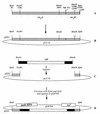Transduction of enteric Escherichia coli isolates with a derivative of Shiga toxin 2-encoding bacteriophage phi3538 isolated from Escherichia coli O157:H7
- PMID: 10473386
- PMCID: PMC99711
- DOI: 10.1128/AEM.65.9.3855-3861.1999
Transduction of enteric Escherichia coli isolates with a derivative of Shiga toxin 2-encoding bacteriophage phi3538 isolated from Escherichia coli O157:H7
Abstract
We investigated the ability of a detoxified derivative of a Shiga toxin 2 (Stx2)-encoding bacteriophage to infect and lysogenize enteric Escherichia coli strains and to develop infectious progeny from such lysogenized strains. The stx(2) gene of the patient E. coli O157:H7 isolate 3538/95 was replaced by the chloramphenicol acetyltransferase (cat) gene from plasmid pACYC184. Phage phi3538(Deltastx(2)::cat) was isolated after induction of E. coli O157:H7 strain 3538/95 with mitomycin. A variety of strains of enteropathogenic E. coli (EPEC), enteroinvasive E. coli (EIEC), Stx-producing E. coli (STEC), enterotoxigenic E. coli (ETEC), enteroaggregative E. coli (EAEC), and E. coli from the physiological stool microflora were infected with phi3538(Deltastx(2)::cat), and plaque formation and lysogenic conversion of wild-type E. coli strains were investigated. With the exception of one EIEC strain, none of the E. coli strains supported the formation of plaques when used as indicators for phi3538(Deltastx(2)::cat). However, 2 of 11 EPEC, 11 of 25 STEC, 2 of 7 EAEC, 1 of 3 EIEC, and 1 of 6 E. coli isolates from the stool microflora of healthy individuals integrated the phage in their chromosomes and expressed resistance to chloramphenicol. Following induction with mitomycin, these lysogenic strains released infectious particles of phi3538(Deltastx(2)::cat) that formed plaques on a lawn of E. coli laboratory strain C600. The results of our study demonstrate that phi3538(Deltastx(2)::cat) was able to infect and lysogenize particular enteric strains of pathogenic and nonpathogenic E. coli and that the lysogens produced infectious phage progeny. Stx-encoding bacteriophages are able to spread stx genes among enteric E. coli strains.
Figures



Similar articles
-
[Construction of a stx2 deletion mutant of Shiga toxin 2 phage phiMin27 and its infectious properties].Wei Sheng Wu Xue Bao. 2008 Sep;48(9):1227-33. Wei Sheng Wu Xue Bao. 2008. PMID: 19062649 Chinese.
-
Prevalence of Stx phages in environments of a pig farm and lysogenic infection of the field E. coli O157 isolates with a recombinant converting Phage.Curr Microbiol. 2011 Feb;62(2):458-64. doi: 10.1007/s00284-010-9729-8. Epub 2010 Aug 10. Curr Microbiol. 2011. PMID: 20697714
-
Diversity of stx2 converting bacteriophages induced from Shiga-toxin-producing Escherichia coli strains isolated from cattle.Microbiology (Reading). 2004 Sep;150(Pt 9):2959-2971. doi: 10.1099/mic.0.27188-0. Microbiology (Reading). 2004. PMID: 15347754
-
Transduction of porcine enteropathogenic Escherichia coli with a derivative of a shiga toxin 2-encoding bacteriophage in a porcine ligated ileal loop system.Appl Environ Microbiol. 2003 Dec;69(12):7242-7. doi: 10.1128/AEM.69.12.7242-7247.2003. Appl Environ Microbiol. 2003. PMID: 14660372 Free PMC article.
-
Antimicrobial Resistance in Diverse Escherichia coli Pathotypes from Nigeria.Antibiotics (Basel). 2024 Sep 26;13(10):922. doi: 10.3390/antibiotics13100922. Antibiotics (Basel). 2024. PMID: 39452189 Free PMC article. Review.
Cited by
-
Grazing protozoa and the evolution of the Escherichia coli O157:H7 Shiga toxin-encoding prophage.Proc Biol Sci. 2007 Aug 22;274(1621):1921-9. doi: 10.1098/rspb.2007.0245. Proc Biol Sci. 2007. PMID: 17535798 Free PMC article.
-
Characterization of a shiga toxin 2e-converting bacteriophage from an Escherichia coli strain of human origin.Infect Immun. 2000 Sep;68(9):4850-5. doi: 10.1128/IAI.68.9.4850-4855.2000. Infect Immun. 2000. PMID: 10948096 Free PMC article.
-
Phage-host interaction: an ecological perspective.J Bacteriol. 2004 Jun;186(12):3677-86. doi: 10.1128/JB.186.12.3677-3686.2004. J Bacteriol. 2004. PMID: 15175280 Free PMC article. Review. No abstract available.
-
Molecular analysis of cytolysin A (ClyA) in pathogenic Escherichia coli strains.J Bacteriol. 2004 Aug;186(16):5311-20. doi: 10.1128/JB.186.16.5311-5320.2004. J Bacteriol. 2004. PMID: 15292132 Free PMC article.
-
Shiga toxin-converting phages and the emergence of new pathogenic Escherichia coli: a world in motion.Front Cell Infect Microbiol. 2014 Jun 20;4:80. doi: 10.3389/fcimb.2014.00080. eCollection 2014. Front Cell Infect Microbiol. 2014. PMID: 24999453 Free PMC article.
References
-
- Bell B P, Goldoft M, Griffin P M, Davis M A, Gordon D C, Tarr P I, Bartleson C A, Lewis J H, Barrett T J, Wells J G, Baron R, Kobayashi J. A multistate outbreak of Escherichia coli O157:H7-associated bloody diarrhea and hemolytic uremic syndrome from hamburgers. The Washington experience. JAMA. 1994;272:1349–1353. - PubMed
-
- Beutin L, Strauch E, Fischer I. Isolation of Shigella sonnei lysogenic for a bacteriophage encoding gene for production of Shiga toxin. Lancet. 1999;353:1498. - PubMed
-
- Campbell A M. Cryptic prophages. In: Neidhardt F C, Curtiss III R, Ingraham J L, Lin E C C, Brooks Low K, Magasanik B, Reznikoff W S, Riley M, Schaechter M, Umbarger H E, editors. Escherichia coli and Salmonella: cellular and molecular biology. Washington, D.C: ASM Press; 1996. pp. 2041–2046.
Publication types
MeSH terms
Substances
LinkOut - more resources
Full Text Sources
Other Literature Sources
Miscellaneous

